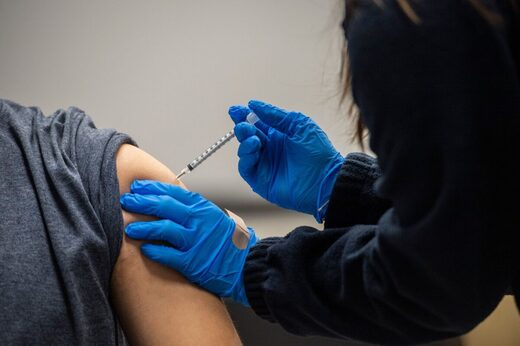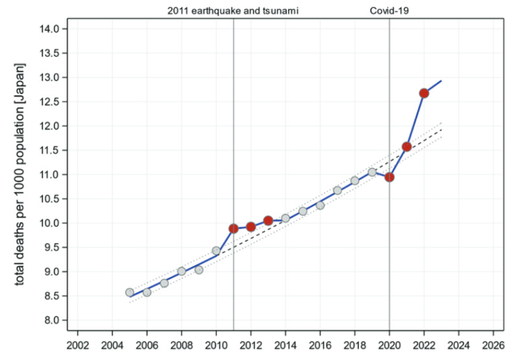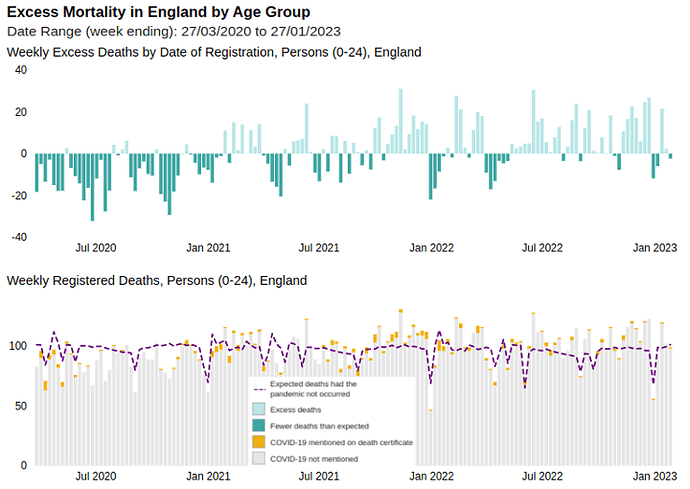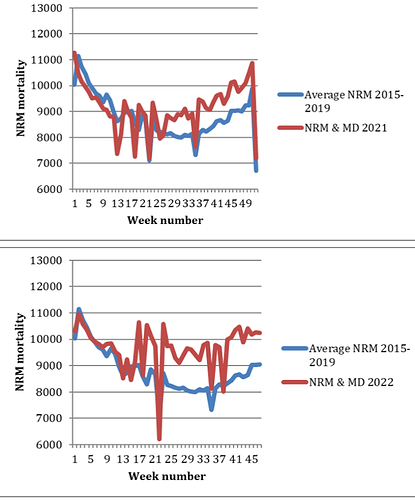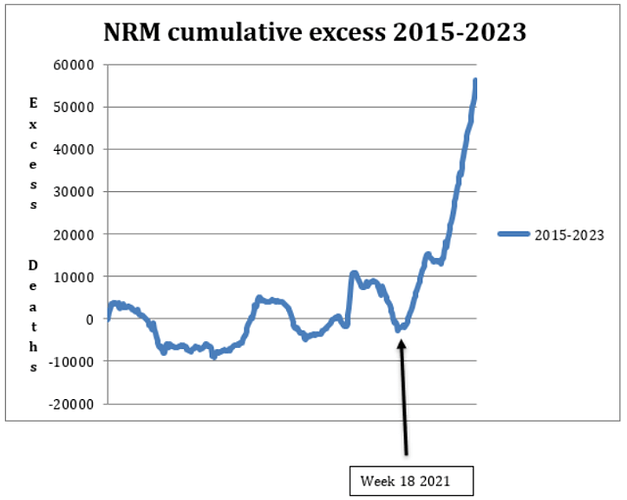Thanks for this @CJ1. Yeah that seems to be the data your were alluding to, that was stopped. Mortality data by vaccination status.
And the article looks to be a very decent dive. I didn’t see anything I might disagree with in the commentary.
Just to pick it up in the second half - noting first Davis/s comment that
"Non-Covid mortality has an increasing relative impact as we continue down the age groups. When we get to the youngest (0–24), the data becomes particularly alarming. "
The graph referred to shows an unexpected rise in deaths in 0-24 age range, beginning January 2021, and from the near absence of covid (marked in yellow), these are non-covid deaths.
Then a good move seems to be made (Davis credits the Daily Sceptic’s Nick Bowler for this analysis) with the focus on non-respiratory mortality, NRM they call it.
As Davis says, leaving out matters around the covid spike, the key point is these non-NRD were stable after that in 2020.
But not in 2021 and 2022, where there was a siginficant and sustained jump in NRD.
There seems to be a seasonal element as this jump isn’t seen in the first 6 months of 2021 or 2021. That I think remains to be explained - but even ignoring that, the jump would still be the same number of deaths even if spread over the whole year.
The salient part of Davis’s article is posted below. (I missed out the section on the z-scores, hoping for greater clarity).
Thanks again @CJ1 for what could be a crucial analysis.
ED
Extract from Davis article
…
…
Non-Covid mortality has an increasing relative impact as we continue down the age groups. When we get to the youngest (0–24), the data becomes particularly alarming.
There is very little alleged Covid–19 mortality among the under-25s. Consequently, the supposed justification to vaccinate the young, regardless of the claims of the UK regulator, the MHRA, is highly dubious—especially in light of the doubtful accuracy of Covid**–**19 mortality attribution.
OHID excess mortality
Sadly, the notable excess mortality among the youngest people in our society—on the record here, at least, for England—is a feature that emerged in mid-2021, apparently becoming entrenched throughout 2022 and into 2023. Even if we accept Covid–19 attribution, very few of these young deaths were caused by it.
…
[Section on z-scores omitted - ED]
…
The Non-Respiratory Mortality Trend
Since any official investigation into the increasing mortality is, so far, conspicious by its absence, we need to look towards independent scientists, statisticians and investigators to try to figure out what’s going on. Detractors will say that these sources are unreliable. The problem is that, in regard to this absolutely essential investigation, there are no other sources.
As pointed out by Nick Bowler, writing for the Daily Sceptic, seasonal mortality variations are largely driven by respiratory illness. These are deaths that are attributable to “influenza-like illnesses” (ILIs), including Covid–19. But seasonal spikes don’t explain the persistent deviation (increase) seen in the Euromomo statistics.
Therefore, if there is another underlying driver, it may be possible to identify what it is by looking at non-respiratory mortality (NRM). As Bowler explains:
Deaths from non-respiratory causes are projected to be a massive 10% higher than expected in 2022. Non-respiratory mortality typically varies little from year to year, changing by a maximum of just 1.3% in each of the six years from 2015 to 2020. However 2021 has registered a 3.72% increase and 2022 is projected to show a catastrophic 10.0% increase. Because it is usually so stable, non-respiratory mortality is a useful way of showing that the ongoing excess mortality currently being experienced in the U.K. is unprecedented and unrelated to normal seasonal variation.
Basing his analysis upon ONS data, Bowler notes:
The large spike in non-respiratory mortality during weeks 14–18 of 2020 (the first five weeks of the pandemic), which resulted in 11,817 non-respiratory excess deaths compared to the 2015–2019 average, is likely a result of Covid death counting errors plus some deaths due to pandemic interventions (withdrawal of treatment, neglect, isolation, etc.), as the rest of the year proceeds completely normally.

NRM for 2020. Source: Daily Sceptic
That is to say, the ONS data shows that the large spike seen in the spring of 2020, which accounts for almost the entire excess for the year, was “officially” recorded to include a simultaneous spike in apparent NRM.
This fact was not reported as avidly by the mainstream media. The sudden spike in NRM was not related to Covid–19, and yet occurred at the same time as “the pandemic”.
Nick Bowler suggests that this may be due to some under-counting of Covid–19 deaths and could also indicate the lethal impact of non-pharmaceutical interventions (NPIs). We have just discussed the many reasons why we might suspect that NPIs also contributed to the simultaneous spike in respiratory deaths, from a range of ILIs, and that Covid–19 numbers were actually exaggerated, not under-reported.
But with regard the NRM, even this isn’t the most salient issue. Despite the ongoing “number of factors” blamed for the subsequent "excess mortality”, by the politicians and the “experts” reported by the mainstream media, NRM remained stable for most of 2020, beyond the spike.
This correlates with the cessation of many of the most notable NPIs and clinical practices that were only present during the 2020 spike. For example, the instruction not to convey vulnerable injured patients to hospital was rescinded from mid-April 2020 onwards, and replaced in May with guidance that stated that hospital Accident & Emergency departments should merely “aim to manage the condition without admission to a hospital bed”. Midazolam prescribing also returned to relatively normal levels in May 2020.
Looking at the period after the spring 2020 anomaly, Bowler considered the increased mortality trend that began to emerge in early to mid-2021. He assigned a mortality displacement (MD) adjustment, advancing the registered date of death by approximately nine weeks.
The MD was necessary for analytical purposes because the most vulnerable—dispassionately, but accurately, described as "dry tinder”—would probably have died anyway within a few months. Their slightly premature deaths, therefore, do not appear in the statistical mortality distribution where we might otherwise expect them to, thus skewing the expected pattern of seasonable variability. In order to make a meaningful comparison with “non-pandemic” years, the MD was included in Bowler’s analysis.
NRMs took off erratically in March 2021 and became a firm “factor” contributing to increasing mortality in the second half of 2021. This is seen in the Euromomo data, and Bowler’s analysis revealed that NRM (accounting for MD—and contrasting with the “non-pandemic” 2015–2019 average) has been the major driver for the increasing mortality we have seen in 2021, 2022 and now well into 2023.
NRM + MD for 2021 and 2022. Source: Daily Sceptic
In his further research into the ONS data, Nick Bowler noted another clear reason why we might consider that the attribution of Covid–19 was potentially unwarranted in a high proportion of claimed cases:
To highlight the overcounting of Covid deaths, one only need compare the data for ‘deaths due to’ against ‘deaths with’ for Covid–19, and contrast it with the figures for other respiratory diseases. For Covid, around 82% of deaths ‘with Covid’ are claimed to be ‘due to’ Covid over the course of the pandemic, yet with all other respiratory diseases only 34% of deaths ‘with’ the disease are claimed to be ‘due to’ it.
This is almost certainly due to the fact that the WHO changed the procedures for recording the ICD10 codes, but only for Covid–19. Suspected and even probable cases of Covid–19 (coded UO7.2) were directed to be entered onto death certificates as “confirmed” (UO7.1). Thus, Covid–19 was far more likely than any other cause, whether respiratory or non-respiratory, to be recorded as the “underlying” cause of death.
Have we been lied to?
In light of everything we have discussed, we have good reason to question whether the whole official pandemic narrative is, in fact, false. If so, the justification for the non-pharmaceutical interventions, those unaccountable policies that appear to have led to the deaths of thousands of people in the United Kingdom, and the justification for the “emergency authorisation” of jabs with questionable efficacy and safety, were also false. These deaths may have been avoidable—and, if that is the case, it appears that government policy is directly to blame.
Bowler then looked at the cumulative levels of “excess” NRM throughout the period 2020 to early 2023. As this was an analysis of annual mortality distribution, he dispensed with the MD adjustment to focus solely upon the total NRM excess. His analysis of the data starkly demonstrates the very strong correlation between increasing excess NRM and the jab roll-out.
NRM “excess” for 2021–2023. Source: Daily Sceptic
Unlike respiratory illnesses, which disproportionately account for mortality among the old, *non-*respiratory mortality—such as cancer, heart disease and suicide—affects younger people to a greater extent than the old. This finding is supported by the OHID data and explains why actuaries are now considering lowering British life expectancy.
As repeatedly noted by UK Column and others, correlation is not causation. It does, however, indicate that the Covid injections have emerged as a possible contributory factor for the increasing mortality trend observed since mid 2021. In addition, we can safely state that the dangerous non-pharmaceutical interventions, imposed as they were prior to the jab roll-out, and the excessive use of medication in measures already known to be lethal are possibly the prime candidates for causation of the sharp spring 2020 anomaly.
We should also consider that Britain’s systemic healthcare problems, which were tending toward increasing mortality prior to 2020, have also been exacerbated by the Government’s response to the alleged pandemic.
We do not know, nor can we know at this juncture, precisely why people in the United Kingdom are dying in unusually large numbers. As it seems that the UK Government is potentially culpable for a high proportion of these deaths, a government-led public inquiry is unlikely to provide any meaningful answers.
In order genuinely to investigate the truth, we need the resources of independent universities, the statistical authorities, science and the medical profession to be dedicated to a real investigation. We may also need the courts to force the reluctant to divulge information if necessary.
Nick Bowler was absolutely on the money when he wrote:
[S]omething extraordinary has been occurring in the trends in core mortality since spring 2021, notably around the time of the Covid vaccination rollout. This worrying trend is currently accelerating and requires an urgent inquiry into whether the vaccinations themselves are playing a part or, if not, what is going on.
While we have been given a narrative about a pandemic disease, an equally plausible explanation is evident. There are other factors that could also account for the mortality patterns that we have seen over the last three years, with or without the presence of any novel respiratory disease.
Unless these factors are ruled out, following a fully independent public-led investigation, there is little reason to simply accept the pandemic story that the Government and the mainstream media would have us believe.
[

Iain Davis
Author, blogger, researcher and short film maker who writes mainly at IainDavis.com.
](Iain Davis | UKColumn)
